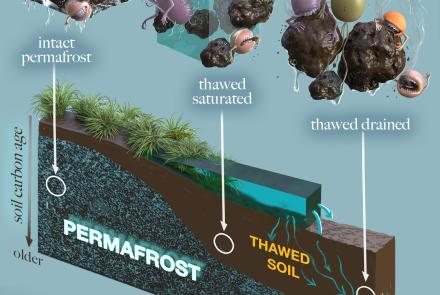
A backyard science expedition, in diapers
My backyard adjoins the thousand-acre wood that makes up the north campus of the University of Alaska Fairbanks.
Several times over the last few decades that I’ve been employed as a science writer, I have written stories set within this large chunk of mostly undisturbed boreal forest.
Today, a researcher visited me here in response to a chat we had at a recent open house at the university. There, I told Leanne Bulger, a student who works with a permafrost scientist, about a peculiar hole in the ground I had noticed on my dog walks.
The fist-size opening in the forest floor seemed to be exhaling. It exhausted so much air during the spring that it had built its own chimney of frost that looked like a snowman.
Bulger seemed interested in taking a look someday. But she was so busy handing chunks of frozen ground to people at the open house that I figured she might forget.
She emailed a day later. We set up a meeting during which we could walk out to the hole and she could measure its exhalations. Those might include methane, the exhaust of tiny organisms feasting on ancient plant or animal life that had been frozen for centuries.
That afternoon, Bulger pulled up in my driveway. As she stepped out of her car, she apologized about not being able to get a babysitter. Then, out of the car popped her daughters. Rose is 6. She wore leather boots that might have been on the wrong feet. Two-year-old Violet followed when freed from her car seat.
“The girls will be going on a science expedition today,” Bulger said.
Bulger apologized again for not being able to secure the gas-measuring kit she had hoped to bring. Her boss, Go Iwahana of the International Arctic Research Center, was using it elsewhere.
With Rose skipping down the forested path after we were joined by Leanne’s colleague Rosie Fordham, we were on our way to the exhaling hole in the ground.
On the way, Violet’s rubber boots fell off as her mom carried her on a hip. Rosie picked them up.
Violet then insisted on walking by herself. Spruce needles clung to her socks as the expedition slowed to a two-year-old’s pace.
The rest of the party was fine with that. It was a sunny day, with new, mint-green leaves unfolding around us, songbirds singing from high branches, and none of the first-hatch mosquitoes that would be thick in a few weeks.
As the science party progressed slowly through the woods, Bulger said her husband was just about to retire from the military. After years of moving across the country as a military wife and mother of four children, she was looking forward to pursuing her own career.
“My husband asked me, ‘What’s your dream job? Not just what you’d do to pay the bills, but something you’d really enjoy,’” she said. “I told him, ‘I want to be a research scientist.’”
For now, she is what Iwahana calls a “student researcher,” helping him in his studies of permafrost, frozen ground that is a relic of colder times and underlies much of northern Alaska.
After a 30-minute walk, we reached the natural feature I started noticing in February, when emissions from a slump in the ground formed a frost chimney. Back then, I could feel air blowing softly on my cheek when I bent down. It had continued to pump air ever since, even after the chimney melted.
Bulger got on her knees in the forested depression and felt the cold breath blowing from one of the two holes.
“How is the air coming out of it?” six-year-old Rose said.
“Great question,” I said. “That’s exactly what we’re trying to find out.”
Another permafrost scientist at UAF said he thought the ground was exhaling due to temperature differences between the air at shoulder level and the air within the void caused by chunks of ancient ice that had melted. The ground might be expelling greenhouse gases, such as methane and carbon dioxide, as is the case as permafrost thaws all over the north.
After finding her measuring tape was not long enough to plumb the depth of one of the holes, Bulger found a stick taller than she is. She shoved it in.
“Oh my god, this is nuts,” she said as the stick disappeared into the hole. “This is enormous.
“This is a site that’s worth getting to know better,” she said, making a mental plan to return with the gas-sniffing device and other tools that would give a better idea of what the offgassing hole was telling us.
By the time we pointed our shoes back toward Bulger’s car, the expedition was almost two hours old. That did not stop Rose from stopping to pick up grouse tailfeathers. Or her mom from pausing to check out interesting fungus on the ground.
“You never want to go for a walk with me,” Bulger apologized again. “I stop for everything.”
Bulger knelt to snap a photo of the fungus with her free hand while Violet rested her head on mom’s shoulder.
The party continued on until we made it back to my driveway. Bulger secured Violet in her baby seat in the back of the car.
“I’ll report what we found to Go and I’m sure we’ll be back for more measurements,” she said. “Thanks for telling me about it.”
Before Bulger had backed out of the driveway, Violet, the youngest member of the all-female science expedition, was sound asleep in the back seat.




